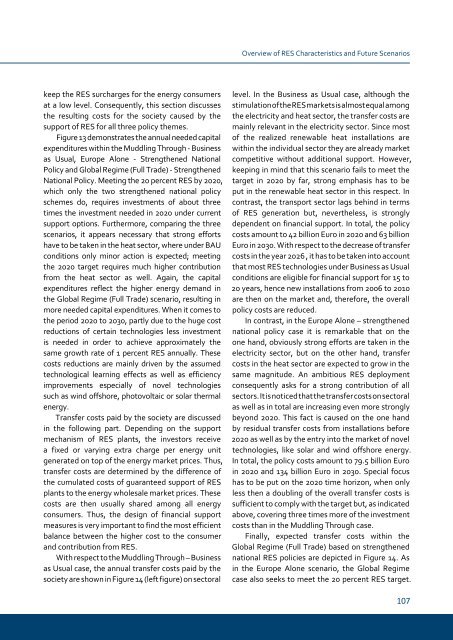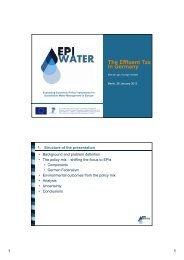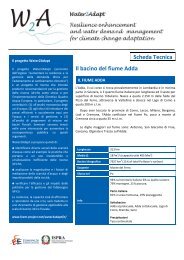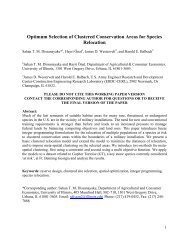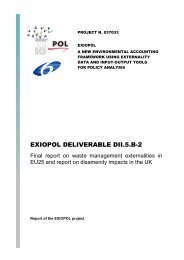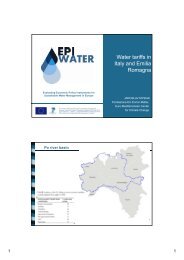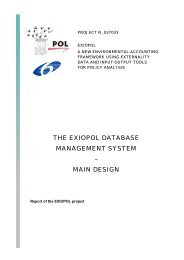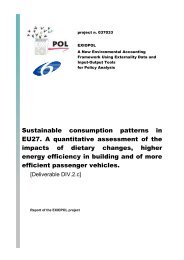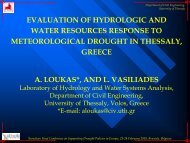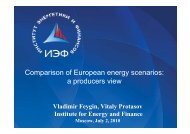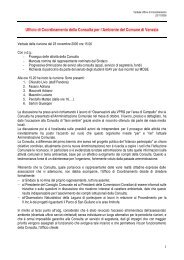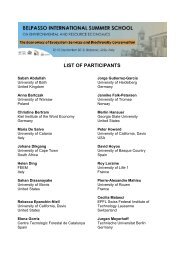Gulf and European Energy Supply Security - Feem-project.net
Gulf and European Energy Supply Security - Feem-project.net
Gulf and European Energy Supply Security - Feem-project.net
Create successful ePaper yourself
Turn your PDF publications into a flip-book with our unique Google optimized e-Paper software.
keep the RES surcharges for the energy consumers<br />
at a low level. Consequently, this section discusses<br />
the resulting costs for the society caused by the<br />
support of RES for all three policy themes.<br />
Figure 13 demonstrates the annual needed capital<br />
expenditures within the Muddling Through - Business<br />
as Usual, Europe Alone - Strengthened National<br />
Policy <strong>and</strong> Global Regime (Full Trade) - Strengthened<br />
National Policy. Meeting the 20 percent RES by 2020,<br />
which only the two strengthened national policy<br />
schemes do, requires investments of about three<br />
times the investment needed in 2020 under current<br />
support options. Furthermore, comparing the three<br />
scenarios, it appears necessary that strong efforts<br />
have to be taken in the heat sector, where under BAU<br />
conditions only minor action is expected; meeting<br />
the 2020 target requires much higher contribution<br />
from the heat sector as well. Again, the capital<br />
expenditures reflect the higher energy dem<strong>and</strong> in<br />
the Global Regime (Full Trade) scenario, resulting in<br />
more needed capital expenditures. When it comes to<br />
the period 2020 to 2030, partly due to the huge cost<br />
reductions of certain technologies less investment<br />
is needed in order to achieve approximately the<br />
same growth rate of 1 percent RES annually. These<br />
costs reductions are mainly driven by the assumed<br />
technological learning effects as well as efficiency<br />
improvements especially of novel technologies<br />
such as wind offshore, photovoltaic or solar thermal<br />
energy.<br />
Transfer costs paid by the society are discussed<br />
in the following part. Depending on the support<br />
mechanism of RES plants, the investors receive<br />
a fixed or varying extra charge per energy unit<br />
generated on top of the energy market prices. Thus,<br />
transfer costs are determined by the difference of<br />
the cumulated costs of guaranteed support of RES<br />
plants to the energy wholesale market prices. These<br />
costs are then usually shared among all energy<br />
consumers. Thus, the design of financial support<br />
measures is very important to find the most efficient<br />
balance between the higher cost to the consumer<br />
<strong>and</strong> contribution from RES.<br />
With respect to the Muddling Through – Business<br />
as Usual case, the annual transfer costs paid by the<br />
society are shown in Figure 14 (left figure) on sectoral<br />
Overview of RES Characteristics <strong>and</strong> Future Scenarios<br />
level. In the Business as Usual case, although the<br />
stimulation of the RES markets is almost equal among<br />
the electricity <strong>and</strong> heat sector, the transfer costs are<br />
mainly relevant in the electricity sector. Since most<br />
of the realized renewable heat installations are<br />
within the individual sector they are already market<br />
competitive without additional support. However,<br />
keeping in mind that this scenario fails to meet the<br />
target in 2020 by far, strong emphasis has to be<br />
put in the renewable heat sector in this respect. In<br />
contrast, the transport sector lags behind in terms<br />
of RES generation but, nevertheless, is strongly<br />
dependent on financial support. In total, the policy<br />
costs amount to 42 billion Euro in 2020 <strong>and</strong> 63 billion<br />
Euro in 2030. With respect to the decrease of transfer<br />
costs in the year 2026 , it has to be taken into account<br />
that most RES technologies under Business as Usual<br />
conditions are eligible for financial support for 15 to<br />
20 years, hence new installations from 2006 to 2010<br />
are then on the market <strong>and</strong>, therefore, the overall<br />
policy costs are reduced.<br />
In contrast, in the Europe Alone – strengthened<br />
national policy case it is remarkable that on the<br />
one h<strong>and</strong>, obviously strong efforts are taken in the<br />
electricity sector, but on the other h<strong>and</strong>, transfer<br />
costs in the heat sector are expected to grow in the<br />
same magnitude. An ambitious RES deployment<br />
consequently asks for a strong contribution of all<br />
sectors. It is noticed that the transfer costs on sectoral<br />
as well as in total are increasing even more strongly<br />
beyond 2020. This fact is caused on the one h<strong>and</strong><br />
by residual transfer costs from installations before<br />
2020 as well as by the entry into the market of novel<br />
technologies, like solar <strong>and</strong> wind offshore energy.<br />
In total, the policy costs amount to 79.5 billion Euro<br />
in 2020 <strong>and</strong> 134 billion Euro in 2030. Special focus<br />
has to be put on the 2020 time horizon, when only<br />
less then a doubling of the overall transfer costs is<br />
sufficient to comply with the target but, as indicated<br />
above, covering three times more of the investment<br />
costs than in the Muddling Through case.<br />
Finally, expected transfer costs within the<br />
Global Regime (Full Trade) based on strengthened<br />
national RES policies are depicted in Figure 14. As<br />
in the Europe Alone scenario, the Global Regime<br />
case also seeks to meet the 20 percent RES target.<br />
10


